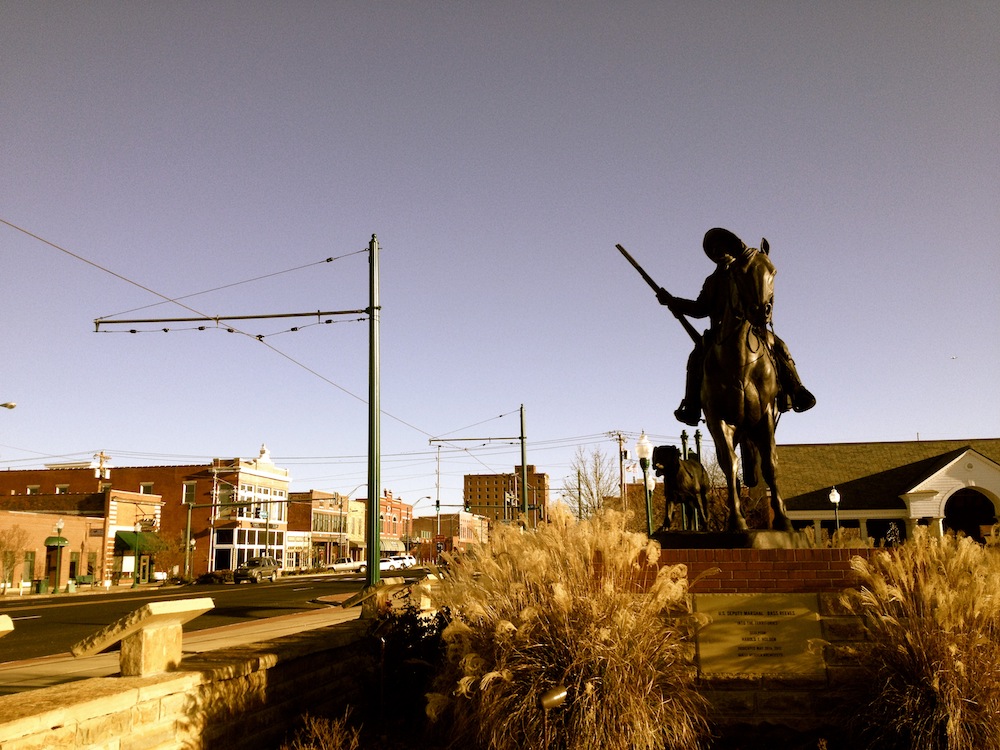I am standing with one boot in Arkansas and the other in Indian Territory. Such a positioning back in the 1800s wouldn’t have been the safest of perches, especially for the traveler just passing through town. Fort Smith, Arkansas has long found its identity destined to its positioning in the world. This small settlement sets up on the Arkansas-Oklahoma border. It grew up as the area’s first frontier fort and served as a key point where Federal marshals rode out of the United States and into Indian Territory. The Wild West was just over the Arkansas River.
Standing where I am in Fort Smith has an air of being dropped into the films that relied on this destined town for a setting, those like True Grit and Hang’em High. I realize just how rough and tough Fort Smith used to be while touring the Fort Smith National Historic Site. Set up in the restored barracks and courthouse building, the museum space details 80 years of turbulent history on the Western frontier.
I begin with the first fort, or at least what is left of it. The first Fort Smith was built in 1817 in order to keep the peace on the Arkansas River valley between the native Osage and Cherokee. And while there is very little to see in terms of the original fort up on this bluff, the views of the Poteau and Arkansas Rivers impress.
A lone fisherman and a handful of pelicans occupy the scene known as Fort Smith Belle Point. My imagination wanders here. I pause to think about the outlaws lassoed into Fort Smith from just beyond the river bend. I pause to ponder the idea of a world beyond that was once incredibly dangerous mostly due to the fact that it was unknown.
By 1838, a second fort was constructed due to the fear of Indian attack. Fort Smith became an important supply depot as steamboats brought goods from St. Louis and New Orleans. Most of Fort Smith’s Wild West history stems from the period from 1872 to 1896 when it was used as a Federal Court. The reconstructed barracks and courthouse building tell of that time in Fort Smith, when U.S. Deputy Marshals rode out into Indian Territory to maintain law and order.
I step into the old barracks and courthouse building, beginning first with the jail. Over a 100 prisoners were held in this space, lending it the nickname, “Hell on the Border”. Just upstairs, you can see where Judge Isaac C. Parker, known as “the hanging judge” for sentencing the most people to death by hanging in U.S. history, conducted his dirty work. Judge Parker presided over one of the largest, deadliest and busiest federal court districts. Again, Fort Smith’s location destined it to its actions.
You could spend a great deal of time uncovering the past stories of Fort Smith, but my stomach is calling. Fort Smith’s history doesn’t end beyond its days on the border of Indian Territory. The traveler will find moments of Fort Smith’s more recent past, like with a stop to Ed Walker’s Drive-In and Restaurant.
I pull up to the old diner, where a sign instructs me to flash my headlights when I am ready to order. It’s a foreign concept to most establishments now, but it is an idea still embraceed in Fort Smith. I head into the red and white diner from 1943 for a taste of its famous French Dipped Sandwich. Ed Walker’s is the only drive-in left in Arkansas where you can have curb service beer. Outlawed practices are still very much alive ironically enough in Fort Smith.
Sitting behind me is none other that Elvis Presley himself, or at least his cut out version. I am reminded that in addition to the U.S. marshals and outlaws, Fort Smith received the King as well. I head to the Fort Chaffee Barbershop Museum, outside of town to see where Elvis received his infamous G.I. haircut. The snipping of the scissors marked the King’s entry into the Army in 1958.
Before I head off back home through what was once Indian Territory and parts of Spain, I pause at the Bass Reeves Monument in downtown Fort Smith. Born a slave to a Texas politician and farmer, Bass Reeves fled to Indian Territory in the 1860s. He was recruited as a federal peace officer for his knowledge of the area. Reeves would go on to become one of the first African Americans commissioned as a federal lawman on the western frontier. I imagine what his life must of entailed, mostly danger and prejudice, I assume. And at the border of Arkansas and the untamed west, where what lay just over the bend was largely a dangerous question mark, I take my boots in that direction. Perhaps with a great deal of true grit, this redheaded stranger and many a traveler can appreciate crossing lines and boundaries into the dangerous unknown.
Have you been to Fort Smith or other once dangerous borders that today sit in their former memories?











I’d love to say I loved this post but I’m still angered at how hungry you’ve made me with the pic of that French Dip! How dare you! The rest of the article is great though. Thanks for helping us brush up on Fort Smith history.